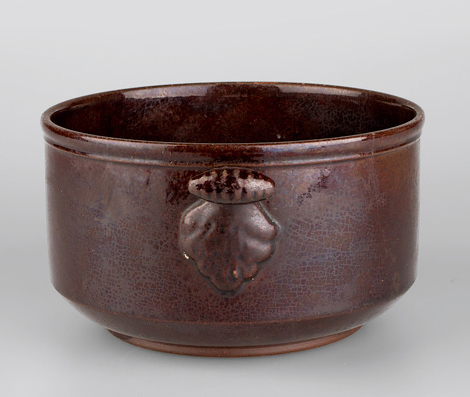
Andreas Heege, Roland Blaettler, 2019
Manganese glaze in CERAMICA CH
The dark brown to black-brown colour of manganese glaze is due to the iron manganese compounds in the glaze formula. Manganese glaze was used on ceramics with a white, red or black-brown slip coating or directly on unslipped vessels.
The high-quality manganese glazes used by the Swiss manufactories in the 19th century were smoothly fused and reflective and were often applied directly to the leather-hard vessels. The main vessel types were tea and coffee sets, pudding and cake moulds as well as plates and tureens. Because these wares usually bear no marks except for those referring to size, their precise origins are often unknown. Based on various criteria (archaeological finds, written sources, occasional marks) we believe that they were made in Kilchberg-Schooren – by the Nägeli, Staub and Scheller factories – (Matter 2012), in Schaffhausen (Ziegler pottery), Aedermannsdorf and perhaps by the pottery factory Pfau&Hanhart in Winterthur. There is also evidence to suggest that they were produced in Bern, as attested to by archaeological finds (Heege 2010, Fig. 56). Other workshops may also have manufactured these wares.
Vessels with manganese glaze were probably also made in the French-speaking part of Switzerland. So-called “brown wares” were produced by the Nyon “Steingut-Fabrik”, perhaps as early as François Bonnard’s time (1845-1859). A strange advertisement appeared in the Gazette de Genève on 11th May 1847 (p. 4), where a ceramic factory was put up for rent, as part of a public limited company “pour fabriquer de la faïence blanche et brune, terre à feu (Kochgeschirr) façon de Paris” [to produce white and brown faience, cookware in the Parisian style]. A letter to the editor (Gazette de Lausanne, 25th March 1879, p. 2) informs us that François Bonnard not only produced “Steingut (industrial fineware or refined white earthenware), but that he had also launched a new line of “terre à cuire brune avec vernis brilliant” [brown cookware with a shiny glaze]. This brown ware subsequently continued – or perhaps had only just begun – to be produced (Bonnard & Gonin, 1859-1860). A notebook by Frédéric Gonin mentions various experiments, e.g. with brown and yellow cookware.
In the period of the public limited company that followed (Manufacture de poteries S. A., from 1860) the same specialty goods continued to be produced (article in the Gazette de Lausanne dated 3rd August 1861, p. 2). At the first Swiss national exhibition in 1883, the manufactory presented “vaisselle blanche” [white ware] and “terres à cuire brunes” [brown cookware] (catalogue).


There is only one verified piece (MHPN 1997-34) bearing the stamped mark “NYON”. The mark was introduced during the Période Delafléchère (1833-1845), and Bonnard may have continued to use it (his output has so far been difficult to identify); it was definitely used during the Bonnard & Gonin period, but only occasionally. The public limited company generally refrained from marking its wares, but regularly impressed vessels with numbers referring to their size. The brown tureen probably dated from the Bonnard & Gonin period (i.e. 1859-1860) or from the period of the public limited company (1860-1870).
Besides these wares from manufactories, other products with manganese glaze were visibly less standardised, suggesting that local potteries also created similar wares (for more information on the topic in general see Heege 2016, 157-161).
In England, vessels with manganese glaze (“Jackfield ware” from Shropshire and North Staffordshire) have older roots that date back to the first half of the 18th century and were particularly popular in the late 18th century (Stellingwerf 2019, 45). Manganese glaze was also used on early Meissen wares and on 18th century products from Bayreuth, Ansbach and Crailsheim (Miller/Ziffer 1994; Harbermann/Arnold 2006; Piereth/Ulrichs 2010).
Translation Sandy Haemmerle
German: Manganglasur
French: Glaçure au manganèse
References:
Blättler 2017
Inventaire national de la céramique dans les collections publiques suisses (1500-1950), vol. III/1, Vaud, Sulgen 2017, 296-297
Harbermann/Arnold 2006
Sylvia Harbermann/Waltraud Arnold, Bayreuther Fayencen. Sammlung Burkhardt. Bestandskatalog, 2. erweiterte Auflage, Bayreuth 2006.
Heege 2010
Andreas Heege, Keramik um 1800. Das historisch datierte Küchen- und Tischgeschirr von Bern, Brunngasshalde, Bern 2010.
Heege 2016
Andreas Heege, Die Ausgrabungen auf dem Kirchhügel von Bendern, Gemeinde Gamprin, Fürstentum Liechtenstein. Bd. 2: Geschirrkeramik 12. bis 20. Jahrhundert, Vaduz 2016.
Matter 2012
Annamaria Matter, Die archäologische Untersuchung in der ehemaligen Porzellanmanufaktur Kilchberg-Schooren. Keramikproduktion am linken Zürichseeufer 1763-1906 (Monographien der Kantonsarchäologie Zürich 43), Zürich 2012.
Miller/Ziffer 1994
Albrecht Miller/Alfred Ziffer, Bayreuther Fayencen: Bestandkatalog (Kataloge der Kunstsammlungen, Bayerische Verwaltung der staatlichen Schlösser, Gärten und Seen), München 1994.
Piereth/Ulrichs 2010
Uta Piereth/Friederike Ulrichs, Museum Deutscher Fayencen in Schloss Höchstädt, München 2010.
Stellingwerf 2019
Wytze Stellingwerf, The Patriot behind the pot. A historical and archaeological study of ceramics, glassware and politics in the Dutch household of the Revolutionary Era: 1780-1815, Zwolle 2019.

